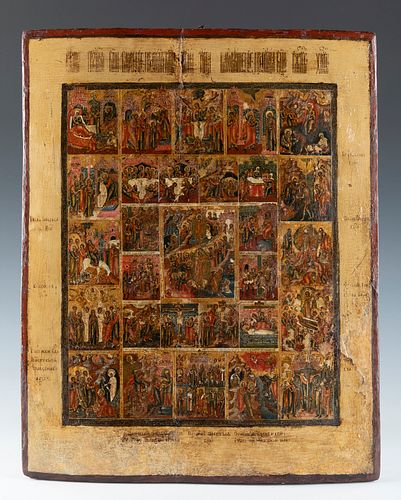Russian school, workshops of the Old Believers, XVIII century. "Resurrection of Christ, Christ's Descent into Hell, and his life in 28 hagiographic s
Lot 89
About Seller
Setdart Auction House
Carrer Aragó 346
Barcelona
Spain
Setdart Subastas was born in 2004 and is currently the first online art auction in Spain with solidity, prestige and reliability guaranteed by our more than 60,000 users. Setdart has a young, dynamic and enterprising team ready to successfully manage the purchase and sale of art works through custom...Read more
Estimate:
EUR€2,500 - EUR€2,700
$2,717.39 - $2,934.78
Absentee vs Live bid
Two ways to bid:
- Leave a max absentee bid and the platform will bid on your behalf up to your maximum bid during the live auction.
- Bid live during the auction and your bids will be submitted real-time to the auctioneer.
Bid Increments
| Price | Bid Increment |
|---|---|
| EUR€0 | EUR€10 |
| EUR€200 | EUR€25 |
| EUR€500 | EUR€50 |
| EUR€1,000 | EUR€100 |
| EUR€3,000 | EUR€200 |
| EUR€5,000 | EUR€500 |
| EUR€10,000 | EUR€1,000 |
| EUR€20,000 | EUR€2,000 |
| EUR€50,000 | EUR€5,000 |
About Auction
By Setdart Auction House
Nov 3, 2021
Set Reminder
2021-11-03 08:00:00
2021-11-03 08:00:00
America/New_York
Bidsquare
Bidsquare : OLD MASTERS
https://www.bidsquare.com/auctions/setdart-auction-house/old-masters-7786
Setdart Auction House sofia@setdart.com
Setdart Auction House sofia@setdart.com
- Lot Description
Russian school, workshops of the Old Believers, XVIII century. "Resurrection of Christ, Christ's Descent into Hell, and his life in 28 hagiographic scenes". Tempera on panel. Measurements: 53 x 42,5 cm. Descent of Christ to hell is one of the most important representations in Christian iconography. This passage was known in Ancient Rus since the XI century, although it obtained maximum popularity in the second half of the XIV century. Iconography of this New Testament passage finally developed in the 17th century in Moscow workshops. In this period, the icon reached its maximum complexity, combining the passages of the New and Old Testament, and in turn, composing in one the scenes of the resurrection and the descent of Christ to hell. The icon of interest, attracts the viewer's attention by its complex structure, concentrating maximum attention on the central register, where, through a complex and dynamic composition, the resurrection and the descent into hell are narrated simultaneously. In both cases the figure of Christ with golden mandorla, is surrounded by various saints, apostles, and Old Testament characters, such as Adam, who is recognized as a bearded man holding Christ's hand. In this section the allegory of hell, represented as an eye, and polychromed in reddish tones, is very striking. The central register is surrounded by two rows of hagiographic scenes, which relate Marian passages, the life of Christ, and his passions. Each of these twenty-eight scenes is astonishing for its pictorial quality, great detail, and architectural richness. Among this horror vacui, a series of details stand out, which help to classify this icon as belonging to the workshops of the Old Believers. For example, the abundance of diverse inscriptions in the frames of the scenes-miniatures, and the typology of the eight-point cross, and with a skull on the feet of Jesus Christ, or the blessing with two fingers, are the most evident signs. The Old Believers were a group of the Orthodox, who after Nikon's ecclesiastical reforms of 1654, decided to follow their opponent Avvakum, defending the traditional foundations of the Orthodox Church. Fleeing persecution, they settled in the villages of Pomorie, near the Urals and in Siberia, although by the 18th century they began to settle in the northern areas near Moscow. The Faith of the Old Believers was legalized in 1905 only, boosting the interest within the Russian Empire for the discovery of the national religious heritage, as well as developing the collecting of ancient icons, never experienced until then.
- Shipping Info
-
In-house shipping available. Please inquire at admin@setdart.com.
-
- Buyer's Premium



 EUR
EUR CAD
CAD AUD
AUD GBP
GBP MXN
MXN HKD
HKD CNY
CNY MYR
MYR SEK
SEK SGD
SGD CHF
CHF THB
THB


















